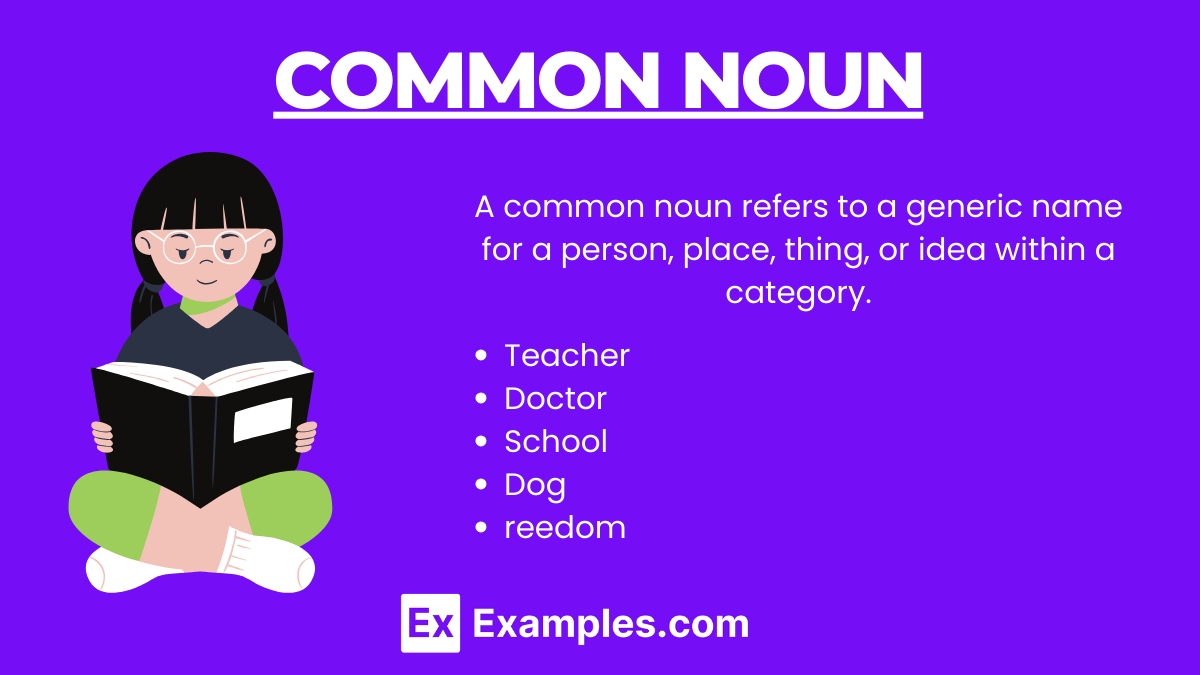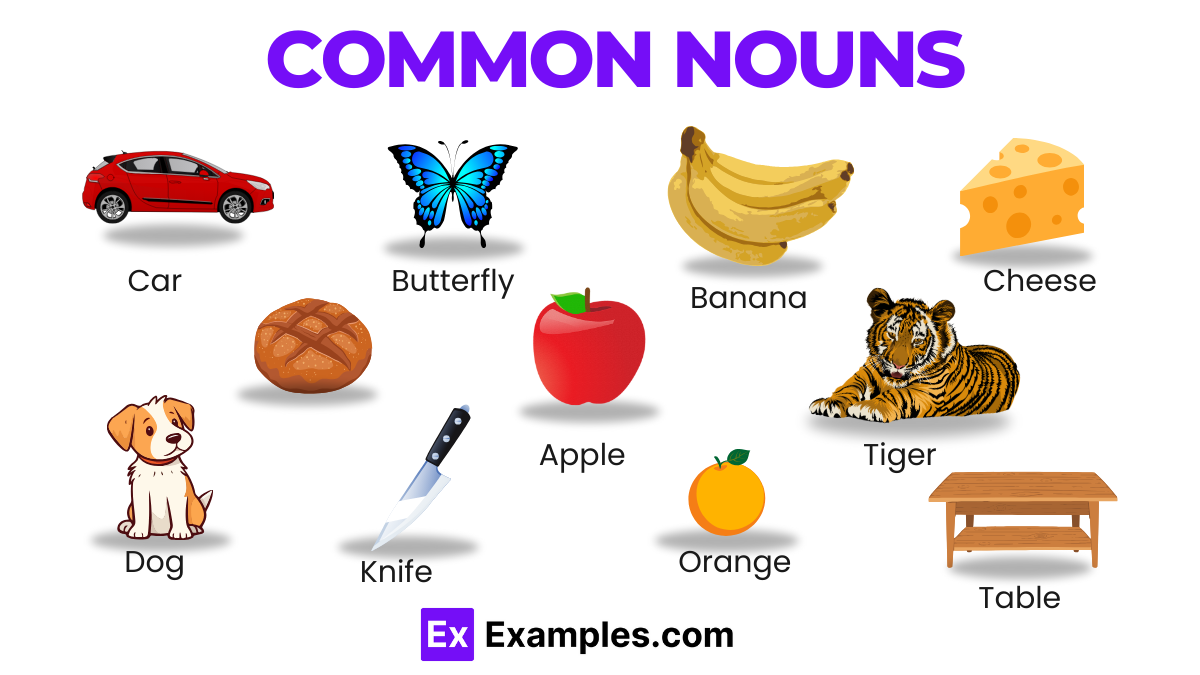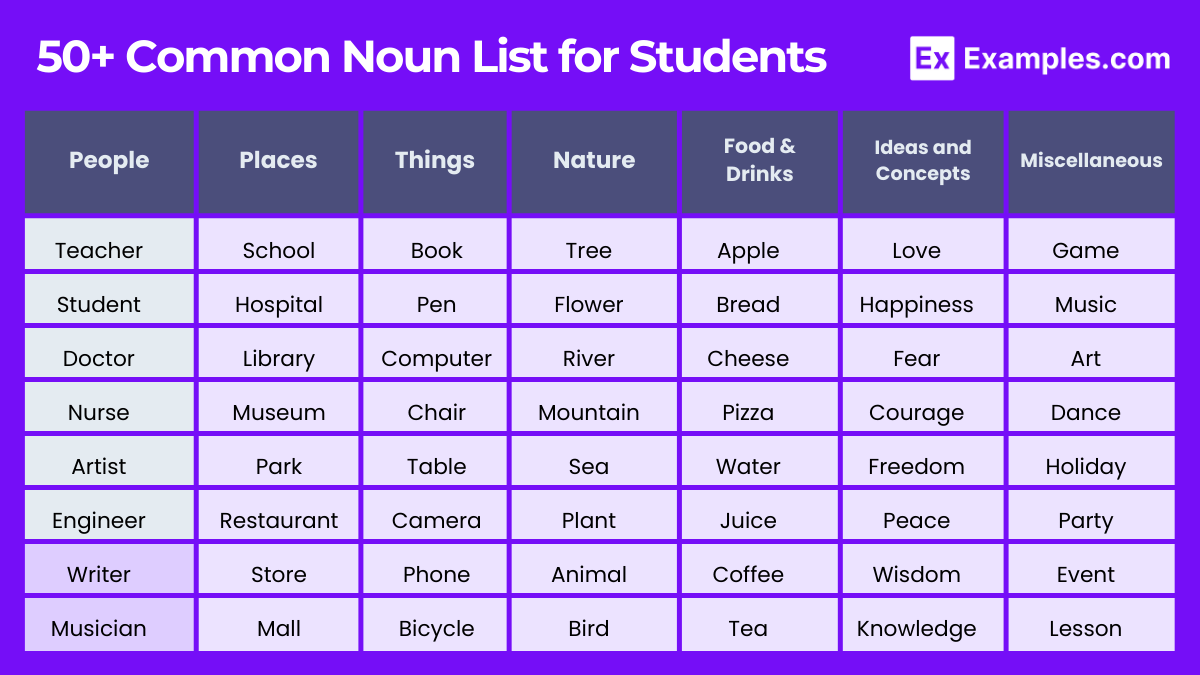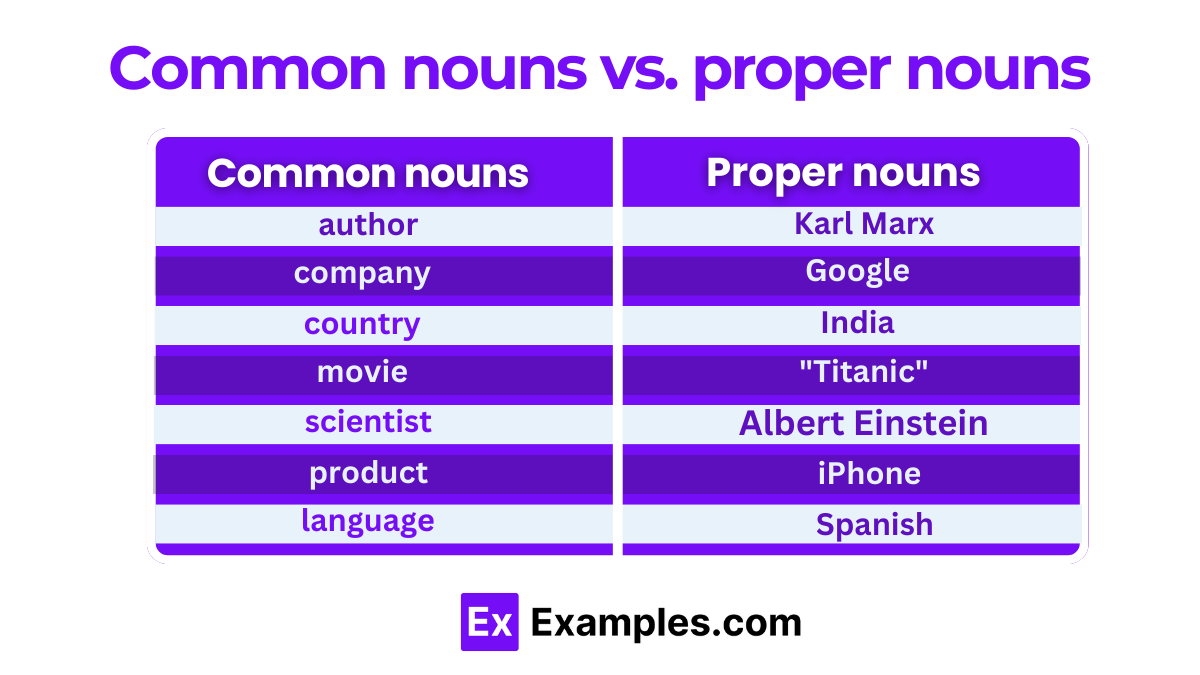8+ Common Noun Examples
People have socially evolved their means of communication as time progresses forward. Soft skills that lean towards communication allow people to understand different subtexts and nuances without them being told directly. One of the ways people do this is through the utilization of common nouns in everyday situations.
What is a Common Noun – Definition
A common noun is a word used to name general items rather than specific ones. It refers to a person, place, thing, or idea without giving it a unique name. Common nouns are not capitalized unless they begin a sentence or are part of a title.
Characteristics of Common Nouns
- General Names: They provide general names for things rather than specific names.
- Capitalization: They are not capitalized unless they start a sentence or are part of a title.
- Types: They can name people (e.g., woman, man), places (e.g., city, park), things (e.g., book, car), or ideas (e.g., happiness, courage).
Examples of Common Nouns
To understand common nouns better, let’s look at some examples categorized by their types:
People
- Teacher: The teacher explained the concept clearly.
- Doctor: A doctor is available in the clinic now.
- Artist: Artists express their emotions through their art.
Places
- School: The school is closed for the holidays.
- Restaurant: We had dinner at a local restaurant.
- City: Every city has its unique culture and history.
Things
- Book: She borrowed a book from the library.
- Car: The car broke down on the way home.
- Table: The table is made of solid wood.
Ideas
- Freedom: Freedom is a fundamental right.
- Love: Love can be found in the smallest gestures.
- Happiness: Happiness is often found in the present moment.
How to use Common Noun
Using common nouns correctly is fundamental to mastering English grammar. Here are some guidelines on how to use common nouns effectively in sentences:
1. Identify the Common Noun
First, understand that a common noun refers to general names of people, places, things, or ideas. Examples include “city,” “teacher,” “car,” and “happiness.”
2. Determine the Proper Article or Determiner
Common nouns often need an article (“a,” “an,” or “the”) or another type of determiner (“some,” “any,” “my,” etc.) before them.
- Use “a” before words that start with a consonant sound (e.g., “a dog”).
- Use “an” before words that start with a vowel sound (e.g., “an apple”).
- “The” can specify something known to the reader or previously mentioned (e.g., “the city”).
3. Capitalize Only When Necessary
Do not capitalize common nouns unless they start a sentence or are part of a title.
- Correct: “The book is on the table.”
- Incorrect: “The Book is on the Table.”
4. Use in Plural Form When Needed
When referring to more than one of something, modify the common noun to its plural form, usually by adding “s” or “es.”
- Singular: “She has a cat.”
- Plural: “She has two cats.”
5. Fit Into Sentence Structure
Common nouns can act as the subject, direct object, indirect object, or complement in a sentence.
- Subject: “Dogs bark.”
- Direct Object: “I love dogs.”
- Indirect Object: “She gave the dogs a treat.”
- Complement: “That sound is a roar.”
6. Combine with Adjectives for Description
You can use adjectives to describe common nouns, giving more detail about the person, place, thing, or idea.
- “She read a captivating book.”
7. Contextual Usage
The meaning and clarity of a common noun can depend on its context within a sentence or conversation. Make sure the noun’s role and reference are clear to the reader or listener.
- Ambiguous: “She went to the bank.”
- Clear: “She went to the river bank.”
Common Nouns That Can Become Proper Nouns
Common nouns can often become proper nouns when they are used to name specific individuals, places, or things. Proper nouns are unique names and are always capitalized. Below are examples of common nouns that can become proper nouns, illustrating how the context changes their classification.
- ocean becomes Pacific Ocean – When referring to a specific ocean.
- city becomes New York City – When naming a specific city.
- country becomes France – When specifying a particular country.
- company becomes Google – When referring to a specific company.
- university becomes Harvard University – When naming a specific institution of higher education.
- river becomes Mississippi River – When referring to a specific river.
- park becomes Yellowstone National Park – When naming a specific national park.
- street becomes Wall Street – When specifying a particular street.
- dog becomes Marley – When naming a specific pet.
- book becomes The Great Gatsby – When referring to a specific book title.
- festival becomes Coachella – When naming a specific festival.
- mountain becomes Mount Everest – When specifying a particular mountain.
- language becomes English – When naming a specific language.
- month becomes January – When referring to a specific month of the year.
- day becomes Thanksgiving – When specifying a particular holiday or significant day.
50+ Common Nouns List for Students
Common nouns vs. proper nouns
Understanding the difference between common nouns and proper nouns is essential in mastering the English language. Both play crucial roles in sentence structure, but they serve different purposes.
| Attribute | Common Nouns | Proper Nouns |
|---|---|---|
| Definition | Names general items, people, or places without specifying them. | Names specific items, people, or places with specific names. |
| Capitalization | Not capitalized unless it’s the first word in a sentence. | Always capitalized, regardless of where they appear in a sentence. |
| Specificity | General and not specific. | Specific and unique. |
| Articles | Often used with articles (a, an, the). | Usually do not use articles before them. |
| Plurality | Can be plural or singular. | Usually singular; when plural, it indicates a collection of specific entities. |
| Examples | city, teacher, car | New York, Mrs. Johnson, Toyota |
Examples of Common Nouns Used in Sentences
Common nouns are words used to name general items, places, people, or ideas. They are not capitalized unless they begin a sentence or are part of a title. Below, you’ll find examples of common nouns used in sentences, ideal for both teachers and students to understand their application in everyday language.
Examples in Sentences
- The city is known for its vibrant culture and bustling markets.
- City is a common noun referring to any urban area.
- She bought a new book to read over the weekend.
- Book is a common noun that refers to a physical or digital publication.
- The river flows gently through the countryside.
- River is a common noun naming a natural watercourse.
- A teacher should inspire creativity and curiosity in students.
- Teacher is a common noun referring to a person who educates others.
- They visited the museum to see the new exhibit.
- Museum is a common noun denoting a place where artifacts are displayed.
- The garden was full of beautiful flowers and butterflies.
- Garden is a common noun representing a planned space for the cultivation of plants.
- Her happiness was evident when she received the good news.
- Happiness is a common noun describing a state of well-being and contentment.
- The dog barked loudly when the mailman arrived.
- Dog is a common noun indicating a domesticated canine.
- He has a great interest in learning foreign languages.
- Languages is a common noun referring to systems of communication.
- We went to the beach to watch the sunset.
- Beach is a common noun naming a sandy or pebbly shore.
Academic concepts are usually common nouns
Academic concepts, which encompass theories, principles, and ideas taught and discussed within educational contexts, are typically categorized as common nouns. These concepts, unlike proper nouns, do not denote specific names of individuals, places, or branded entities, but rather refer to general categories of knowledge or fields of study. Below is a table format that illustrates several examples of academic concepts as common nouns, further clarifying this classification.
| Academic Concept (Common Noun) | Description |
|---|---|
| democracy | A system of government by the whole population. |
| gravity | A force that attracts a body toward the center of the earth. |
| evolution | The process by which different kinds of living organisms are thought to have developed. |
| algebra | A branch of mathematics dealing with symbols. |
| literature | Written works, especially those considered of superior or lasting artistic merit. |
| psychology | The scientific study of the human mind and its functions. |
| sustainability | The ability to be maintained at a certain rate or level. |
| photosynthesis | The process by which green plants use sunlight to synthesize foods. |
| ethics | Moral principles that govern a person’s behavior. |
| quantum mechanics | A branch of physics dealing with the mathematical description of the motion and interaction of subatomic particles. |
Guidelines for Recognizing a Common Noun
- General Names: Common nouns are general names for a type of person, place, thing, or idea. They do not refer to the name of a specific individual, place, brand, or entity. For example, “city” is a common noun, while “New York City” is a proper noun.
- Capitalization: Common nouns are not capitalized unless they begin a sentence or are part of a title. This is one of the simplest ways to differentiate them from proper nouns, which are always capitalized.
- Articles and Determiners: Common nouns often appear with articles (a, an, the) or other determiners (this, that, every, some). For instance, “a teacher,” “the car,” and “some ideas” all feature common nouns.
- Plural Forms: Most common nouns can be made plural, usually by adding “s” or “es” at the end. This change indicates that common nouns can represent one or more items, unlike proper nouns, which are usually singular. For example, “dog” becomes “dogs,” and “city” becomes “cities.”
- No Specific Identification: When a noun does not provide specific identification by itself and needs additional information to identify the subject, it’s likely a common noun. For instance, “river” is a common noun until it’s given a specific name like “Nile,” at which point it becomes a proper noun.
Common nouns are lowercase
Common nouns are indeed typically written in lowercase, except when they begin a sentence or are part of a title. This characteristic is one of the fundamental rules of English grammar, distinguishing common nouns from proper nouns, which are always capitalized. Common nouns refer to general items, people, places, or ideas, rather than specific names.
Key Points about Common Nouns and Lowercase Usage
- General Rule: Common nouns are written in lowercase because they name general types of objects, animals, concepts, or people, rather than specific ones.
- Sentence Starters: If a common noun starts a sentence, it should be capitalized, but this does not change its status as a common noun.
- Titles and Headings: In titles and headings, common nouns may be capitalized according to title capitalization rules, but this is a stylistic choice rather than a grammatical necessity.
Examples Demonstrating Lowercase Usage
- General Use: “The cat sat on the mat.”
- Beginning of Sentences: “Water is essential for life.” Here, “water” is a common noun that is capitalized because it starts the sentence.
- In Titles: “The Mystery of the Missing Necklace.” In this title, even common nouns like “mystery,” “missing,” and “necklace” are capitalized, following title capitalization rules.
Common Noun Worksheet Examples
1. Common Noun Template

Size: 87 KB
Download2. Use of Articles with Common Nouns
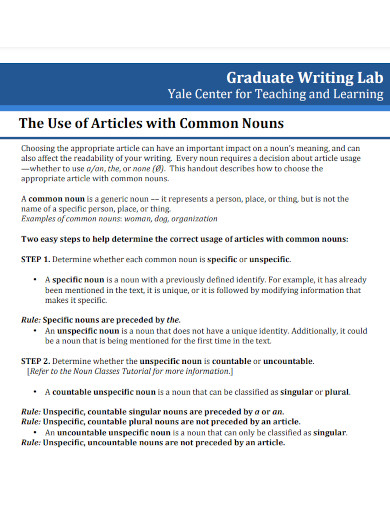
Size: 81 KB
Download3. ELA Common and Proper Nouns
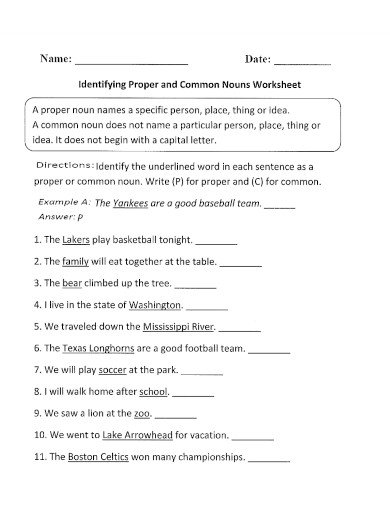
Size: 36 KB
Download4. Sort the Common and Proper Nouns
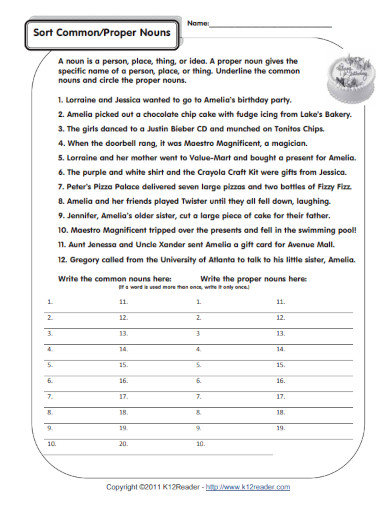
Size: 71 KB
Download5. Identifying Proper and Common Nouns Worksheet
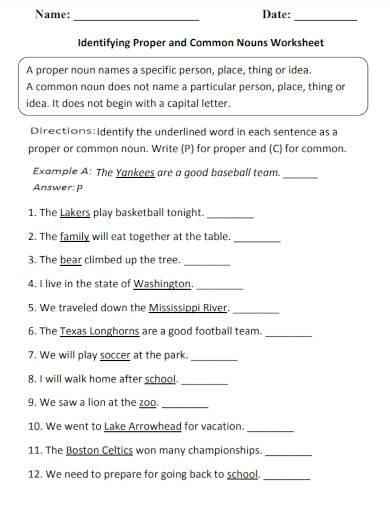
Size: 60 KB
Download6. Common Noun Capitalization Rules
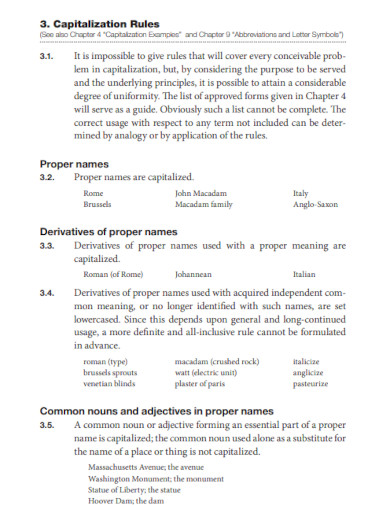
Size: 68 KB
Download7. Common Nouns Answer Sheet

Size: 75 KB
Download8. Grammar Monday Common Noun
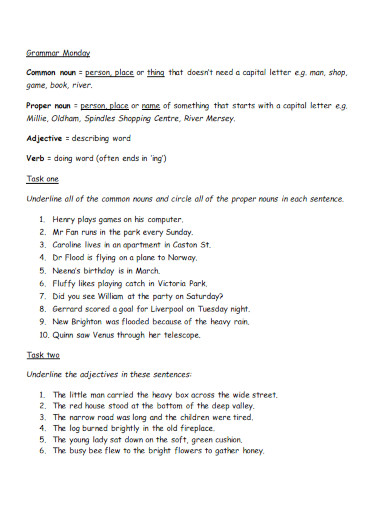
Size: 58 KB
Download9. Distinguishing Common and Proper Nouns
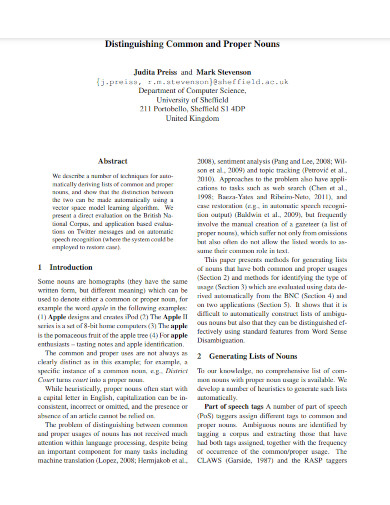
Size: 87 KB
DownloadHow to Distinguish Common Nouns From Proper Nouns
Most of the time common nouns follow a specific format or template that is very easy to follow and spot. But there are occasions when a common noun is harder to distinguish, which can create vague details and makes room for miscommunication. Therefore you need to identify common nouns from proper nouns. If you want to work on your understanding of common nouns then you may use any of the common noun worksheets and common noun sortation exercises on the list above.
Step 1: Check for Capitalization
All proper nouns are capitalized as per their rule and structure, but not all capitalized nouns are proper. Start by checking if the noun has any capitalization and is not located at the beginning of the sentence. If the noun is capitalized but is at the beginning of the sentence, check if the noun refers to something specific, but if the noun is not capitalized then it is a common noun.
Step 2: Discern the Context
Sometimes context can change the common noun into a proper noun. This is true if a person nicknames something with a common noun, then the noun will be considered a proper noun. All of this means that you must discern the overall context used in the text.
Step 3: Determine If the Noun Refers to Something Unique
When a common noun is used to give a title or uniquely names something, then the noun will be considered a proper noun. Determine whether or not the noun will refer to something unique as that can recategorize the noun.
Step 4: Identify the Nouns Specificity
Some nouns specify a specific species of animal but are still considered common nouns. For example, a chicken is a common noun but an Ayam Cemani or Black Chicken is a proper noun. This means that you must identify whether or not the specifics of the noun are unique or general.
FAQs
Can I refer to someone I know using common nouns?
Yes, you may, but this is wholly dependent on the context of the conversation, text, book, or dialogue. One of the best ways to use common nouns is to indirectly refer to someone you know in a conversation without the person you are referring to. For example, “Hey Alexa. I know I’ve met that girl before, but I forgot her name.” Another context this situation might fit in is that you have given a common noun nickname to your friend or loved one. An example might be that you call your Mother “mom” as a term of endearment.
Are nicknames considered common or proper nouns?
Nicknames are alternate label other people give to other entities or objects, that is unique to them. If the nickname is a shortcut to a proper noun like the shortening of Alexa into Lex or Alex, then the nickname is considered a proper noun. If the nickname titles a specific entity or object and is something unique to it then it is also considered a proper noun. An example of this occurrence can be found in the movie The Thing, where it refers to the extraterrestrial entity as The Thing. This means that all nicknames are going to be considered proper nouns since it refers to a unique identifier that refers to and represents an entity or object. Common nouns are a subtype of nouns that refer to a label or name that is both generic and general.
All things can be referred to by a set of common nouns and proper nouns. For example, a person can be both called a man (common noun) and be given a proper noun named Steven. When writing something, it is very important to know when to use common nouns, as they are generally very vague.


